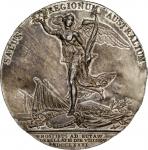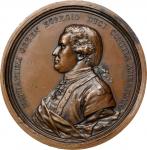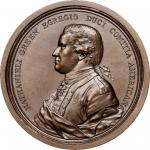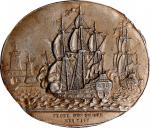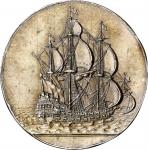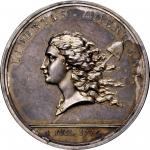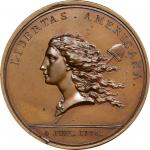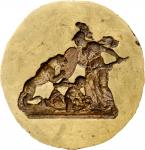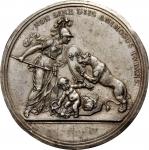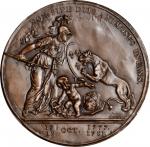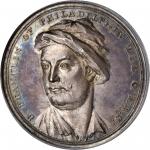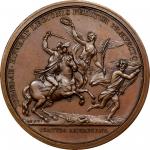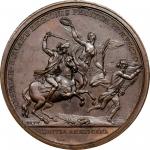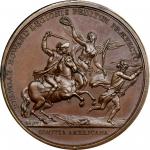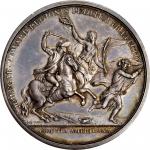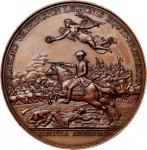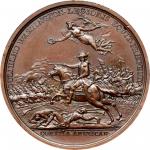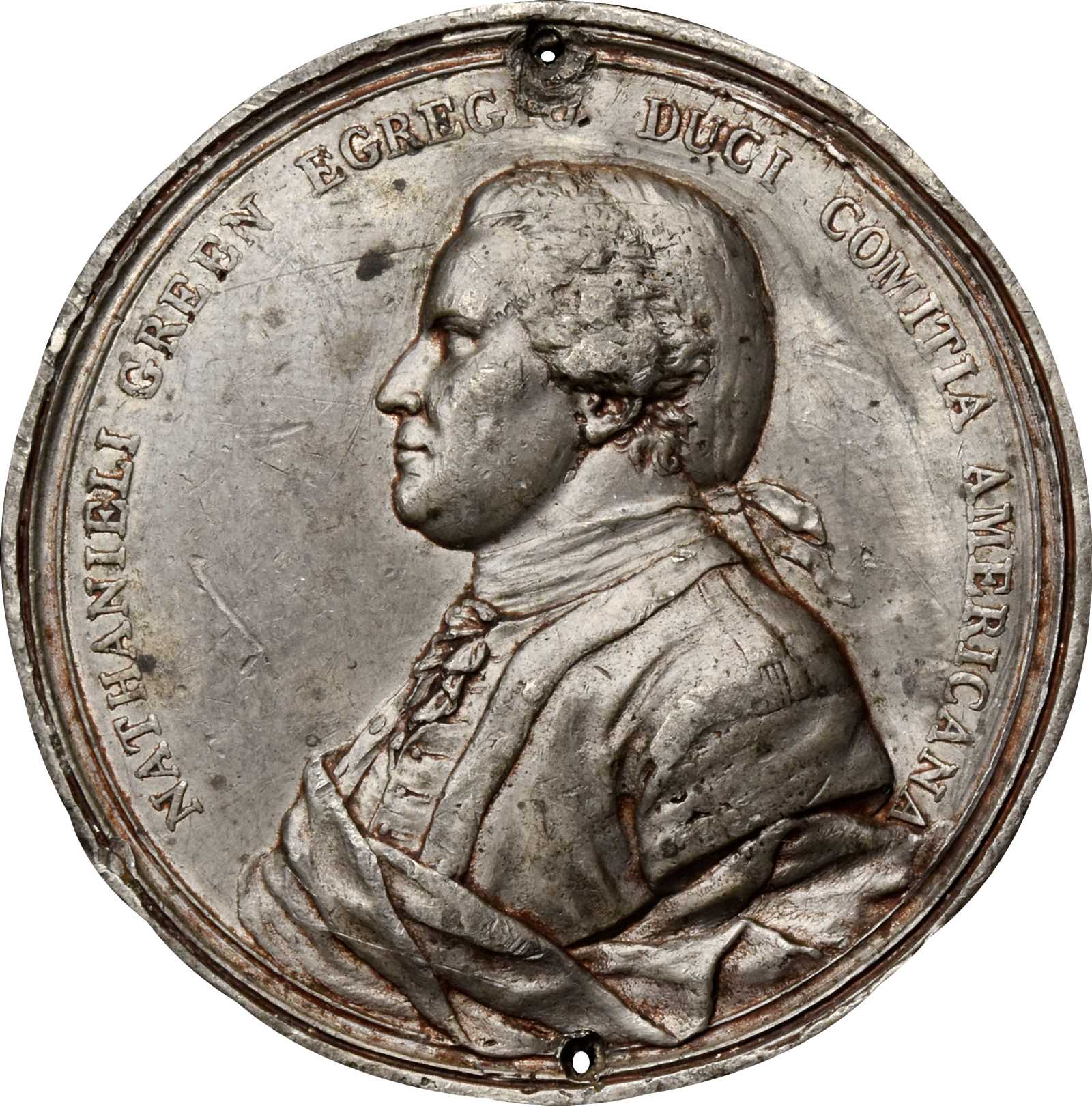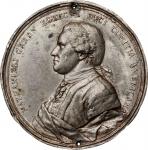1781 (i.e. ca. January-February 1787) Nathanael Greene at Eutaw Springs obverse cliche. As Betts-597. White metal. Original. Workshop of Augustin Dupre. 55.6 x 55.4 mm, 455.8 grains. 1.8 - 2.8 mm thick. Very Fine, twice holed.Plain trimmed edge. Paper backed, with fiber covering most of the surface. Holed inside the rim at 12:00 and 6:00, as if once mounted. Attractive and even pewter gray with hard, glossy surfaces. A bit worn on the high points, somewhat wavy in the fields, and showing an old scratch in the middle of the left field, but actually very attractive overall. <p>This is the only obverse splasher for this medal we have encountered in private hands. There are others in the historical record: the Chapman brothers cataloged one in their April 1886 sale as lot 2030, described as "Artists proof in lead of obv. Bent. Very Fine. Unique. Medal extremely rare." At a sales price of 20 cents, its tough to tell if it was just a lead cast of the obverse or an actual cliche. The set of cliches sold in Henry Chapmans June 1911 Charles Morris sale, lot 574, didnt get much love either; they brought a dime for the pair. Alas, we encounter no others that have ever sold. There is a really beautiful obverse splasher in the American Philosophical Society collection, and the 1857 New York State Library inventory records an obverse shell in tin, but no other examples have come to your catalogers attention.<p>As a product of Dupres design process, likely intended for the eyes of Thomas Jefferson or one of his colleagues, this piece has a fascinating history. Considering that we have no idea how the set of tin cliches Jefferson brought home for James Madison was mounted and displayed, we cant help but wonder if this might not be one of them.<p><strong>A Note On Trials: Cliches, Epreuves, and Splashers </strong><p><p>The Adams Collection of Comitia Americana and related medals is uniquely enriched by several specimens of a unique form of medallic production that is known by several different names. Typically struck from a die in its earliest state, usually before hardening, these trials were called epreuves - proofs - in the original French correspondence between Dupre and Duvivier and the Founding Fathers charged with the acquisition of the medals the Continental Congress authorized. In more modern numismatic literature, they are more often called cliches or splashers, the latter term being a fair description of just how these trials were made.<p>Unhardened dies are incredibly susceptible to damage, as 18th century die steel (and modern steel today) is brittle before it is hardened by quenching. Once a die is hardened, modification becomes very difficult, so if changes need to be made, they need to be done in that fragile, unhardened state. Engravers in major mints - Paris especially - were accustomed to making soft metal impressions as something of a proofreading copy, enabling the negative die to be viewed in the positive in rough draft form. Wax impressions were liable to leave bits of wax in the interstices of design elements, thus engravers settled upon tin (usually called "white metal" in modern numismatic circles) as the best medium.<p><p>Tin melts at 450 degrees Fahrenheit, a low enough melting point to be accomplished in any small workshop. A ladle full of molten tin poured onto a surface will cool and harden fairly quickly, but remain soft long enough that a die can be easily pushed into it by hand, leaving a relatively durable impression in medal. Most often, medalists would find a piece of scrap paper - a note, a newspaper, a book page - to pour the tin atop, thus preventing their workspace from getting scorched and making the tin sheet somewhat easier to lift and trim. <p><p>These splashers were not intended to be medals, or even permanent, but simply a temporary way to display the state of the die in the positive before its devices were rendered immovable. Each was personally crafted by the engraver in his shop. In the case of the Comitia Americana medals, the epreuves made by Duvivier, Dupre, and Gatteaux were ultimately intended to be viewed and handled by themselves and those close to the process. Benjamin Franklin reviewed the epreuves of the De Fleury medal between April 20 and May 4, 1780, then made recommendations regarding the lettering in the obverse exergue that were adopted by Duvivier. He later did the same with his Libertas Americana medal, correcting a spelling error on the reverse. Engraver Augustin Dupre retained many of his splashers in his personal collection, some of which found their way into institutions in France and the United States, some of which are in the present sale.<p><p>Thomas Jefferson used cliches as a spendthrift (and lightweight) way to collect all the medals of the Comitia Americana series, assembling a set for himself and another for his Virginia countryman James Madison. As he was preparing to depart Paris in September 1789, he wrote to Madison to let him know of the boxes he was shipping, including a box of books and several crates full of Houdons John Paul Jones busts that the sitter wanted to have distributed in America. <p><p><em>I have put a collection of the proofs in tin of the medals voted by the U. S. (except two, of which the dies are in America) the medals themselves not being allowed to be taken, I desired the workmen to let me have two sets of their last proofs; for their manner is, as their work proceeds, to make impressions of it in pure tin, in order to correct &c. These proofs are in fact more delicate than the medals themselves, and the last of them shew the impressions complete. I have had them arranged in a frame, under glass &c. & beg your acceptance of them.</em><p><p>By "delicate," Jefferson did not mean fragile, but well-detailed. The modern whereabouts of these sets are unknown; it is very possible that some proportion of either of these sets are in the current sale.<p><p>Jeffersons set left Monticello in February 1798 in the hands of an enslaved man named York, who Jeffersons son-in-law and overseer, the abusive drunkard Thomas Mann Randolph, called "allmost (sic) an idiot." Randolph told Jefferson that the thief had confessed, listing off an inventory of items from Jeffersons chambers including "some impressions in lead & tin of Dies of the Medals & Coins." He continued "I have some hope of recovering the proofs of Medals (tis from the description I conclude they are out) I have traced one to a Negroe of the neighbourhood who bt. it of York but he says he has lost it." The historical record on the theft and recovery thereafter falls silent; Jefferson wrote several consecutive letters to Randolph after the receipt of this letter but never acknowledged the incident. Two different men named York were enslaved by Jefferson concurrently, one of whom was inherited from the estate of Jeffersons father-in-law in 1774 and described as a "Waterman," the other of whom was born in 1781 and labored at Monticello. Presumably the York involved here was the latter of these two, aged 17 at the time of his act of resistance against Jeffersons authority.<p><p>Today, cliches of each of the Comitia Americana medals are extremely rare, with populations in the low single digits. There is not a single issue in this format that is known to the extent of 8 or 10 pieces. Matched sets of obverse and reverse are the exception rather than the rule. Each of the survivors is an accident, a piece that was made to serve a purpose at a moment in time, not produced for long-term preservation in a cabinet. Their historicity is exceptional, as each survivor was not only in the hands of the medals engraver, but likely in the hands of Thomas Jefferson, Benjamin Franklin, David Humphreys, or a small number of others. Their rarity surpasses that of their normally struck cognates in nearly every circumstance.<p><p>With the possible exception of the Charles Senter Collection, sold at auction in 1933, no cabinet has ever included such a wide array of these historic rarities as the John Adams Collection.<p><strong>The Battle of Eutaw Springs</strong><p><strong>The Action:</strong><p>After Guilford Court House turned into a draw that was too costly for Cornwallis to do anything but regroup far to the east, Nathanael Greene turned south. Washingtons most trusted former deputy continued his plan to harass and divide the British forces that remained in South Carolina, by picking his spots and ensuring that resupply and communication lines with British-held Charleston were difficult to maintain. He met British commander Lord Rawdon back in Camden, where a young ruffian named Andrew Jackson was being held prisoner. Greene suffered a mild defeat at the indecisive Battle of Hobkirks Hill in April 1780. Rawdon evacuated Camden soon thereafter, knowing he was surrounded by American Continentals and local militia on all sides. Greene turned inland, meeting a newly reinforced force under Rawdon at Ninety-Six on the Carolina frontier in June 1780. The summer passed quietly. Rawdon returned to Charleston, then left for England - and was captured by deGrasse at sea. Lt. Col. James Stewart was left in charge of the British military presence in South Carolina. Nathanael Greene regained strength, attracted reinforcements, and waited.<p>His moment to strike came during the dog days of late August. Francis Marion, the legendary Swamp Fox, found his way to Greenes position, meeting forces under Lt. Col. Light-Horse Harry Lee (a Comitia Americana medal recipient for Paulus Hook), militia under General Andrew Pickens, and the seasoned troops commanded by Comitia Americana medal recipients Lt. Col. John Eager Howard and Lt. Col. William Washington. Greene took more than 2,000 men onto the field at Eutaw Springs, most of them well experienced and ready to fight.<p>Stewarts regulars and loyalists were almost as numerous as Greenes forces when they first encountered each other on the morning of September 8. Loyalist Capt. John Coffin, a Boston native (whose brother Sir Isaac Coffin was responsible for the [1827] Tristram Coffin medal cataloged as Betts-533), was the first to find the Patriot forces, while out on the morning forage. By 9 AM, battle lines had formed. Before long, both sides were disorganized and scattered. William Washington had fallen prisoner into British hands. By the time the smoke cleared, Greene had taken more than 500 British prisoners as well. Both sides held portions of the field when the skies opened with rain, and both had lost dozens of dead and a couple hundred wounded. Stewart withdrew to a position closer to the coast. Greene controlled the interior. <p>The battle had been something of a draw, but Greenes strategy had won. He had kept Cornwallis Southern force divided and occupied British attention in the Carolinas. He kept his army together, and he controlled most of inland South Carolina. As Greene played cat and mouse in the Southern Department, Cornwallis marched to his doom in Virginia. He arrived in Yorktown on August 1, a month before Eutaw Springs. When Greenes army left the field on September 8, the French Navy had taken control of the Chesapeake, sailed up the James River, and essentially sealed Cornwallis fate. Within a week, Washington and Lafayette arrived on Virginias Middle Peninsula. The game was up. Greene had played his part flawlessly, and helped assure American victory. Congress voted him a gold medal barely a week after Cornwallis laid down his arms for the last time.<p><strong>The Resolution:</strong><p><em>Resolved, That the thanks of the United States in Congress assembled, be presented to Major General Greene, for his wise, decisive and magnanimous conduct in the action of the 8th of September last, near the Eutaw Springs, in South Carolina; in which, with a force inferior in number to that of the enemy, he obtained a most signal victory over the British army commanded by Colonel Stewart:</em><p><em>That the thanks of the United States in Congress assembled, be presented to the officers and men of the Maryland and Virginia brigades, and Delaware battalion of continental troops, for the unparalleled bravery and heroism by them displayed, in advancing to the enemy through an incessant fire, and charging them with an impetuosity and ardor that could not be resisted:</em><p><em>That the thanks of the United States in Congress assembled, be presented to the officers and men of the legionary corps and artillery, for their intrepid and gallant exertions during the action:</em><p><em>That the thanks of the United States in Congress assembled, be presented to the brigade of North Carolina, for their resolution and perseverance in attacking the enemy, and sustaining a superior fire:</em><p><em>That the thanks of the United States in Congress assembled, be presented to the officers and men of the state corps of South Carolina, for the zeal, activity and firmness by them exhibited throughout the engagement:</em><p><em>That the thanks of the United States in Congress assembled, be presented to the officers and men of the militia, who formed the front line in the order of battle, and sustained their post with honor, propriety and a resolution worthy of men determined to be free.</em><p><em>Resolved, That two pieces of field Ordnance be presented to Major General Greene by the Commander in Chief, with a motte engraved "from the United States in Congress Assembled to Major Genl. Greene, in honour of the Victory obtained under his Command near the Eutaw Springs in So Carolina on the 8th. September A. D. 1781.</em><p><em>Resolved, That a Sword be presented to Colo Williams of the Maryland line for his great military skill and uncommon exertions on this occasion.</em><p><em>Resolved, That a British standard be presented to Major General Greene, as an honorable testimony of his merit, and a golden medal emblematical of the battle and victory aforesaid:</em><p><em>That Major General Greene be desired to present the thanks of Congress, to Captains Pierce and Pendleton, Major Hyrne and Captain Shubrick, his aids de camp, in testimony of their particular activity and good conduct during the whole of the action:</em><p><em>That a sword be presented to Captain Pierce, who bore the generals despatches, giving an account of the victory, and that the Board of War take order herein.</em><p><em>Resolved, That the thanks of the United States in Congress assembled, be presented to Brigadier General Marion, of the South Carolina militia, and the officers and men under his Com for his wise, gallant and decided conduct, in defending the liberties of his country; and particularly for his prudent and intrepid attack on a body of the British troops, on the 30th day of August last; and for the distinguished part he took in the battle of the 8th of September.</em><p><em>- Continental Congress Resolution of October 29, 1781</em><p><em></em><strong>The Acquisition:</strong><p>Even though Greenes heroic actions at Eutaw Springs were the latest to earn the honor of a Congressional medal, his medal was the second one delivered, following only the one Franklin finished so quickly for De Fleury and Stony Point. Franklin finished only that first effort; David Humphreys bested him by one, seeing only this medal and the one for Horatio Gates through to completion.<p>It was a coup that Humphreys was able to hire the uber-talented Augustin Dupre to accomplish Greenes medal. It would be the first of three Comitia Americana medals Dupre would engrave, followed by the medals for Morgan and Jones, though Dupre would gain lasting American fame for his Libertas Americana medal. <p>On November 19, 1785, Humphreys and Dupre signed a contract for the completion of the Nathanael Greene medal, requiring Dupre to produce an obverse depicting a portrait of General Greene and a reverse with "Victory treading under her feet broken arms, with the legend and the exergue," strike 24 medals exactly, and deliver the dies and medals to Humphreys upon their completion. John Adams, holding the Congress European pursestrings in Paris, wrote home to John Jay to report "Humphreys brought with him, an order upon Mr Grand for Money to pay for a Medal to be Struck for each of the Generals Washington, Gates and Green … As We Supposed it to be the Undoubted Intention of Congress that these Small Presents should be made in honour of those great Events and immortal Actions, I consented to draw for the Money upon the Same Bankers to the Amount of about a Thousand Pounds. this also I hope will meet the Approbation of Congress."<p>Dupre ran into a few snags along the way. He asked Humphreys to get him a new likeness of Greene after the painted miniature wasnt working as proper inspiration for an engraved profile portrait. Humphreys passed the request along to Secretary of War Henry Knox in May 1786. The lengthy delay Humphreys tolerated from Dupre was apparently one of the principal reasons it fell to Duvivier, not Dupre, to accomplish General Washingtons medal, the first authorized and ostensibly most important Comitia Americana medal of them all.<p>A year passed, during which Humphreys left Paris. Thomas Jefferson took over, and on February 14, 1787, he wrote to John Jay that he was in receipt of Greenes gold medal, 23 examples in bronze, and the dies, which he reported he had "sealed up" and "shall retain till I am honored with [Congresss] orders." A month later, Jeffersons secretary William Short packed up the lot and sent them home, with an update for John Jay:<p><em>Agreeably to Mr.: Jeffersons directions on his leaving Paris, I have the honor of forwarding to Your Excellency, the medal engraved for Genl. Greene, under the resolution of Congress. There is one of gold and twenty three of bronze, all of which are committed to the care of Mr. Walton of New York, who sails in the French Packet the 25th. of this month. The medal for Genl. Gates ordered by Congress and contracted for by Colo. Humphries is not yet finished; but will certainly be in time to be sent by the May Packet.</em><p>Alas, Greene had passed to his reward on June 19, 1786. <p>The Presentation:<p>Like John Stewart, Nathanael Greenes passing before his medal was completed required Congress to find a next of kin to whom his medal could be presented. The gold medal and its dies arrived in the United States and were delivered into the hands of Arthur St. Clair, the President of Congress on July 6, 1787. On August 9, St. Clair sent the gold medal to Jeremiah Wadsworth, the famous Connecticut financier and patriot who served as Greenes executor. <p>St. Clairs letter was sold as lot 378 in Stan V. Henkels April 1891 sale of Washington Relics consigned by Lawrence Washington, Bushrod Washington, and Thomas B. Washington, though how the letter came to be in their possession is unclear. The catalog excerpts the letter as follows:<p><em>It is much to be regretted, and l do most sincerely regret, that General Greene did not survive to receive this further testimony of the sense his country had of his services, particularly of the gallant action at the Eutaw. The memory of it, however, will be thereby long preserved, and it cannot fail to be very acceptable to his family. And when the story is related to his children, and the design of the medal explained to them, as it will be, whilst their veneration for their father is increased, a sense of gratitude and affection for their country, thus careful to accord his Glory, must be raised in their tender minds, and the generous resolution instantly formed to step forward in its service in the same honorable faith, should it ever be necessary, with the honest hope of meriting like rewards.</em><p>The paper trail goes silent after that, though most sources agree that Wadsworth passed the medal along to Kitty Greene, the generals fetching young widow, then just 32 years old. Julian appears to be the only source for the claim that Wadsworth also presented Ms. Greene the original dies. Whether she received the dies or not, they have not been seen since. Greenes gold medal survives, the property of the state of Rhode Island, on deposit at the Rhode Island Historical Society.<p><strong>The Nathanael Greene at Eutaw Springs Medal:</strong><p><strong>Obverse: </strong>A portrait of Greene in profile facing left, wearing his military uniform but also draped (a symbol of his recent passing?), surrounded by the legend NATHANIELI GREEN EGREGIO DUCI COMITIA AMERICANA or "To Nathanael Greene, distinguished leader, from the American Congress." This is the only Comitia Americana medal to incorporate the words COMITIA AMERICANA into a non-exergual inscription.<p><strong>Reverse: </strong>In the words of the Humphreys-Dupre contract of 1785, "Victory treading under her feet broken arms," including flags, a fasces, a broken sword, a split shield, a helmet, and a broken arrow, along with an olive branch. Around the top periphery, SALUS REGIONUM AUSTRALIUM or "Safety in the Southern regions. In the exergue, HOSTIBUS AD EUTAW DEBELLATIS DIE VIII SEPT MDCCLXXXI, meaning "The enemy utterly defeated at Eutaw, September 8, 1781." The signature DUPRE is hidden above the left side of the exergual line.<p>From the John W. Adams Collection. Acquired from Stack’s sale of the John J. Ford, Jr. Collection, Part XIV, May 2006, lot 225. Earlier, from the Ted Craige Estate on October 4, 1982.

